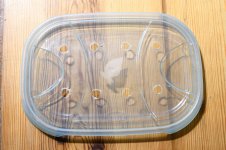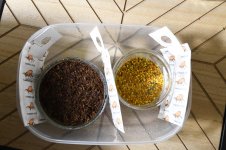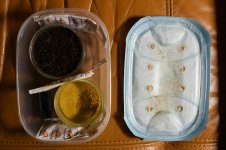Marijuana Gangster
Well-known member
Wassup Brothers and Sisters,
for nearly half a year I have problems with spider mites and with thrips but to a smaller extent. I use to spray my plants in a rotation of azadirachtin and pyrethrum preparates and it works but after a while, and especially when I have flowering plants that I cannot spray anymore, the infestation comes back. So I decided to dive into the topic of using predatory mites for biological pest control and found out that you can breed some species easily. Species like Amblyseius cucumeris (against thrips) and Amblyseius californicus (against spider mites) are used preventatively to control thrips and spider mites and can feed on pollen in the absence of prey. This is the key for breeding them, because species like Phytoseiulus persimilis are much more efficient in killing spider mites but they are monophag and will die when no prey is available. This makes it more difficult to breed in the long perspective because you would also have to breed the spider mites (which I am trying to get rid of ). So I thought I will give the Amblyseius spec. a try and follow the instructions that I read online to breed them. Of course I will not do this without sharing the experience with you people.
). So I thought I will give the Amblyseius spec. a try and follow the instructions that I read online to breed them. Of course I will not do this without sharing the experience with you people.
So as it seems, there are only a few things to look out for, there has to be food, the relative humidity needs to be above 60% and the temperature should be constant at about 25 °C. Then you need to prepare some tupperware which will be the home to the mites. I drilled some holes in the lid so they get oxygen.

Then I taped a cleaning rag on top of the lid so that the mites wont escape the box.

Afterwards I took two small containers, one to put the pollen in and the other to put some coco substrate in. The pollen serves as food and the Amblyseius lay their eggs here, while the coco substrate is moistened and will help to keep the humidity up. It also serves as a shelter. Then you just buy a pack of predatory mites, place it inside the box and close it.
Amblyseius cucumeris

Amblyseius californicus

I open the box twice a day, before and after work, to prevent the pollen from molding and to let some fresh air inside. I just bought some small temperature and RH sensors today which I will also put in the box to monitor the conditions inside. Thats about it, I will keep you updated on how these mites develop.
one love and keep it G
and keep it G 
MG
for nearly half a year I have problems with spider mites and with thrips but to a smaller extent. I use to spray my plants in a rotation of azadirachtin and pyrethrum preparates and it works but after a while, and especially when I have flowering plants that I cannot spray anymore, the infestation comes back. So I decided to dive into the topic of using predatory mites for biological pest control and found out that you can breed some species easily. Species like Amblyseius cucumeris (against thrips) and Amblyseius californicus (against spider mites) are used preventatively to control thrips and spider mites and can feed on pollen in the absence of prey. This is the key for breeding them, because species like Phytoseiulus persimilis are much more efficient in killing spider mites but they are monophag and will die when no prey is available. This makes it more difficult to breed in the long perspective because you would also have to breed the spider mites (which I am trying to get rid of
So as it seems, there are only a few things to look out for, there has to be food, the relative humidity needs to be above 60% and the temperature should be constant at about 25 °C. Then you need to prepare some tupperware which will be the home to the mites. I drilled some holes in the lid so they get oxygen.

Then I taped a cleaning rag on top of the lid so that the mites wont escape the box.

Afterwards I took two small containers, one to put the pollen in and the other to put some coco substrate in. The pollen serves as food and the Amblyseius lay their eggs here, while the coco substrate is moistened and will help to keep the humidity up. It also serves as a shelter. Then you just buy a pack of predatory mites, place it inside the box and close it.
Amblyseius cucumeris

Amblyseius californicus

I open the box twice a day, before and after work, to prevent the pollen from molding and to let some fresh air inside. I just bought some small temperature and RH sensors today which I will also put in the box to monitor the conditions inside. Thats about it, I will keep you updated on how these mites develop.
one love
MG




